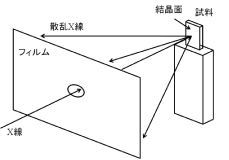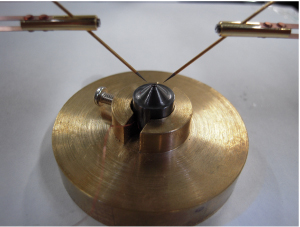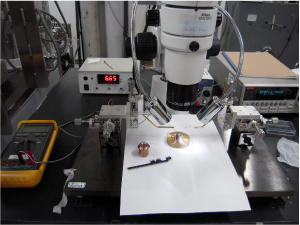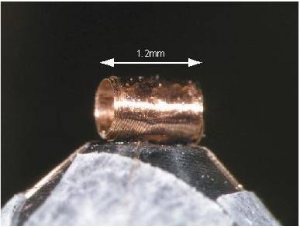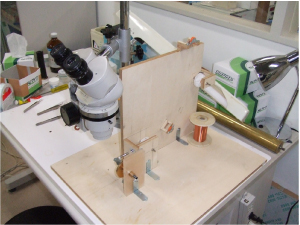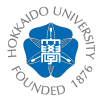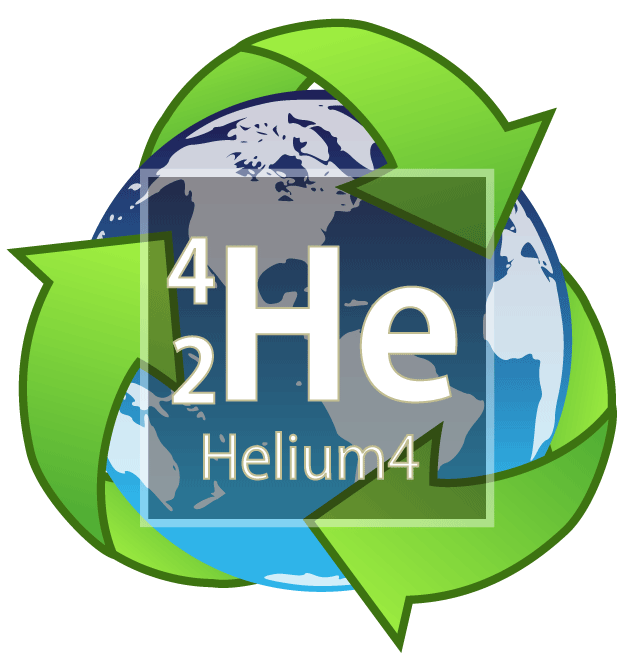
MPMS用ピストンシリンダーによる高圧下DC磁化測定
ドイツ・Braunschbeing工科大学Stefan Su(ウムラウト)llow 教授らによって開発されたDC磁化測定用の単層式ピストンシリンダーセル(Cu-Be合金製)です。市販のSQUID磁力計(MPMS, Quantum Design社)に取り付け可能となっており,理想的なSQUID電圧波形が得られるように非常に細長い構造になっています(全長~150 mm)。温度は2 K、圧力は約1 GPa(10000気圧)までの測定が可能です。
図1 MPMS用ピストンシリンダーセル概観
X線を用いた物質評価
アーク炉やプラズマジェット炉で作製した試料をX線を用いて評価します。評価の手法はラウエ法、粉末ディフラクトメーター法、EPMA(Electron Probe Micro Analyzer)です。 ・ラウエ法 図1のようにX線を単結晶試料に当てて、散乱したX線でフィルムを感光させます。このときブラッグの反射条件を満たしてX線が強めあうと図2のように黒い斑点がフィルムに現れます。この斑点の対称性(4回対称、鏡映面等)は結晶の対称性を反映しているので結晶面の対称性、軸方向が分かります。|
図1 ラウエ法の概念図(背面反射法) |
図2 ラウエ写真の例 |
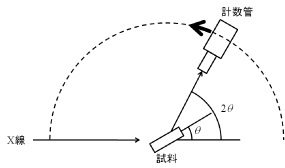
図3 粉末ディフラクトメーター法の概念図
・EPMA 試料に電子線を照射すると図5のような反応がおこります。この中の特性X線いうものは波長が原子によって決まっているX線です。電子線を照射したときに飛び出してくる特性X線の波長のスペクトルを調べることで電子線の当たった領域の構成元素と割合が分かります。
図4 電子線を試料に照射したときの反応
インデンターセルを用いた高圧下電気抵抗・交流帯磁率測定

図1 インデンターセル概観
インデンターセルの簡単な模式図を図2に示しています。中心に穴の開いたNi-Cr-Al合金製ブロック(hole piece)にあけた穴に液体の圧力媒体を満たし、先端部分に試料を取り付けたインデンター(NMWC:非磁性タングステン鋼)を差し込みます。この状態からプレス機で加圧することによって、hole pieceの穴を変形させて圧力を発生させる仕組みです。圧力はロックナットを締めることで保持しています。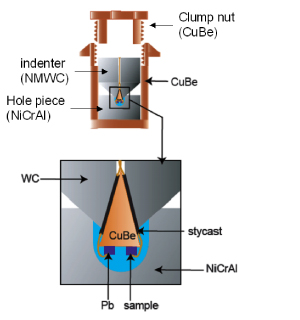
図2 インデンター型圧力セルの模式図
電気抵抗測定には4端子法を用いています。端子付にはスポット溶接や銀ぺーストなどをもちいています。(図3)非常に細かい作業のため写真のように顕微鏡を見ながらの作業となるため学生たちもはじめは苦労しますが 、一か月ほどで誰でもセッティングができるようになります。(図4)
|
図3 スポット溶接をしているところ |
図4 |
図6は私たちの研究室の学生が手作りした「巻き線機」です。手作り感たっぷりですが、1mm以下のコイルを非常に美しく巻くことができる優れモノです。
図5 インデンターセルに内蔵する微小コイル |
図6 ホームメイド「巻き線機」 |
Topics: Double ultrasonic dispersions due to rattling in SmOs4Sb12
|
Magnetic-Field-Independent Ultrasonic Dispersions due to Rattling in the Magnetically Robust
Heavy Fermion System SmOs4Sb12 Tatsuya YANAGISAWA, Yoichi IKEDA, Hitoshi SAITO, Hiroyuki HIDAKA, Hiroshi AMITSUKA, Koji ARAKI, Mitsuhiro AKATSU, Yuichi NEMOTO, Terutaka GOTO, Pei-Chun HO, Ryan E. BAUMBACH, and M. Brian MAPLE |
Elastic properties of the filled skutterudite compound SmOs4Sb12 have been investigated by ultrasonic measurements. The elastic constant C12(\omega) shows two ultrasonic dispersions at ∼15 K and ∼53 K for frequencies \omega between 33 and 316 MHz, which follow a Debye-type formula with Arrhenius-type temperature-dependent relaxation times, and remain unchanged even with applied magnetic fields up to 10 T. The corresponding activation energies were estimated to be E2 = 105 K and E1 = 409 K, respectively. The latter, E1, is the highest value reported so far in the Sb-based filled skutterudites. The presence of magnetically robust ultrasonic dispersions in SmOs4Sb12 implies a possibility that an emergence of a magnetically insensitive heavy fermion state in this system is associated with a novel local charge degree of freedom which causes the ultrasonic dispersion. J. Phys. Soc. Jpn. 80 (2011) 043601. (also available on cond-mat/1010.1387)
Figures (a) Comparison of the ultrasonic dispersions that appear in elastic constant C11 of ROs4Sb12 (R = La-Sm) at several frequencies. Lower arrowheads with numbers 1 and 2 indicate the relaxation point \omega\taui ∼ 1 for i = 1 and 2, respectively. (\omega is ultrasonic frequency and \tau is relaxation time) The displayed data have been shifted to eliminate overlapping with each other and the SmOs4Sb12 data are magnified three times for the \Delta C11/C11-axis. (b) Arrhenius plots of the characteristic parameters of the ultrasonic dispersions (Attempt time: \tau0(i), Activation Energy: Ei) for ROs4Sb12 (R = La-Sm). (*This research was performed at UC San Diego, Hokkaido University, and Niigata University in 2010.) |
Topics: Double ultrasonic dispersions due to rattling in SmOs4Sb12
|
Magnetic-Field-Independent Ultrasonic Dispersions due to Rattling in the Magnetically Robust
Heavy Fermion System SmOs4Sb12 Tatsuya YANAGISAWA, Yoichi IKEDA, Hitoshi SAITO, Hiroyuki HIDAKA, Hiroshi AMITSUKA, Koji ARAKI, Mitsuhiro AKATSU, Yuichi NEMOTO, Terutaka GOTO, Pei-Chun HO, Ryan E. BAUMBACH, and M. Brian MAPLE |
Elastic properties of the filled skutterudite compound SmOs4Sb12 have been investigated by ultrasonic measurements. The elastic constant C12(\omega) shows two ultrasonic dispersions at ∼15 K and ∼53 K for frequencies \omega between 33 and 316 MHz, which follow a Debye-type formula with Arrhenius-type temperature-dependent relaxation times, and remain unchanged even with applied magnetic fields up to 10 T. The corresponding activation energies were estimated to be E2 = 105 K and E1 = 409 K, respectively. The latter, E1, is the highest value reported so far in the Sb-based filled skutterudites. The presence of magnetically robust ultrasonic dispersions in SmOs4Sb12 implies a possibility that an emergence of a magnetically insensitive heavy fermion state in this system is associated with a novel local charge degree of freedom which causes the ultrasonic dispersion. J. Phys. Soc. Jpn. 80 (2011) 043601. (also available on cond-mat/1010.1387)
Figures (a) Comparison of the ultrasonic dispersions that appear in elastic constant C11 of ROs4Sb12 (R = La-Sm) at several frequencies. Lower arrowheads with numbers 1 and 2 indicate the relaxation point \omega\taui ∼ 1 for i = 1 and 2, respectively. (\omega is ultrasonic frequency and \tau is relaxation time) The displayed data have been shifted to eliminate overlapping with each other and the SmOs4Sb12 data are magnified three times for the \Delta C11/C11-axis. (b) Arrhenius plots of the characteristic parameters of the ultrasonic dispersions (Attempt time: \tau0(i), Activation Energy: Ei) for ROs4Sb12 (R = La-Sm). (*This research was performed at UC San Diego, Hokkaido University, and Niigata University in 2010.) |
